1955 Monaco Grand Prix race report: Trintignant triumphs where others fail
Maurice Trintignant takes his debut win and Ferrari's first of season; Alberto Ascari crashes his Lancia into harbour
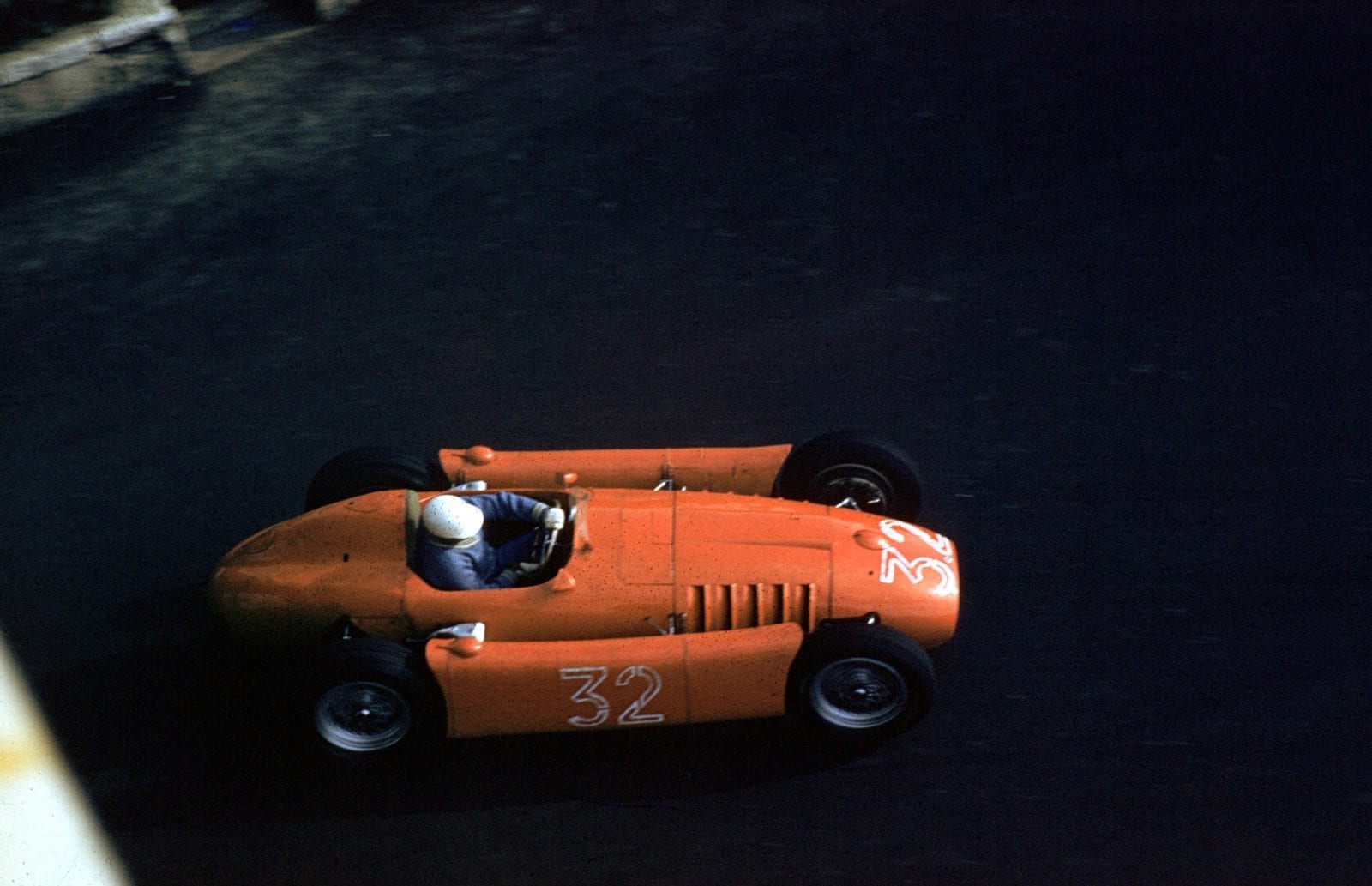
Motorsport Images
The town of Monte Carlo was recently reinstated as a racing circuit on May 22nd for the first time since 1952, and the meeting was given the title of the European Grand Prix. More important, however, was the fact that the Grand Prix of Monaco was the second round in the World Championship, and the first in Europe for 1955.
The anticipation of this first Grande Epreuve has made itself felt strongly throughout Europe for some weeks, and the entry proved to be one of the finest seen for many a year. It was the first 1955 appearance in Europe of the W196 Mercédès-Benz cars and in view of the fact that the Monaco circuit is a tortuous one the Stuttgart firm built two special cars for the race.
These were shorter in the wheelbase than any previous models, and as a result there was no room for the inboard brakes at the front, so these were mounted normally, on the wheel hubs. At the same time this saved a great deal of weight, with the lack of drive shafts and universals; at the rear the brakes remained in the normal position.
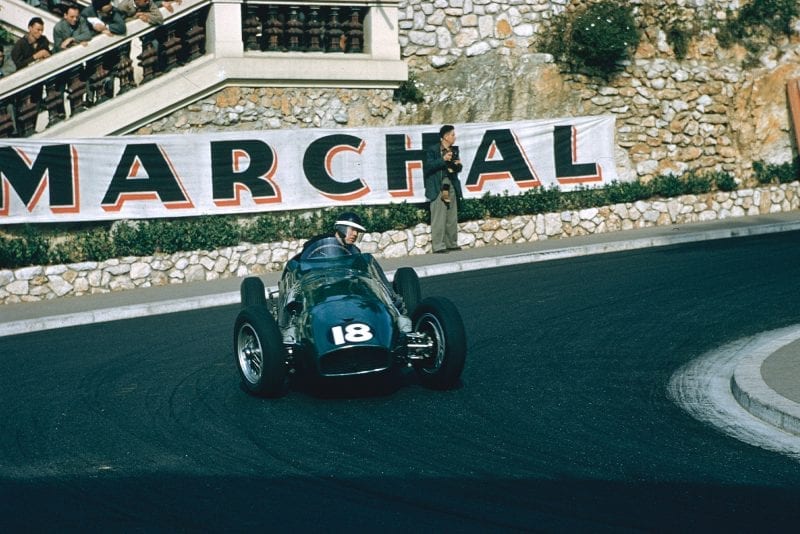
Despite his Vanwall being stuck on a ferry during first practice, Hawthorn managed to qualify twelfth
Motorsport Images
Other than this major alteration the two short-chassis cars were similar to the Argentine models, though the car given to Fangio had the engine mounted slightly farther forward, while the car Moss drove had it in the normal position, relative to the driver that is. Having no knowledge on the handling of these very short cars, the Mercédès-Benz engineers made the two cars slightly different in order to learn something. Their third entry was a long-chassis car with all four brakes inboard and in the hands of Herrmann, as Kling was not fully recovered from his Mille Miglia accident.
Gordini entered a team of three cars, Manzon and Pollet with the-earlier chassis models, but the former car now fitted with Messier disc brakes, and Bayol was on the only 1955 model. Then Rosier and Simon were down to compete with their private Maseratis and Macklin with the Maserati of Moss, disc brakes, Dunlop wheels and all. Two Vanwalls were entered, with Hawthorn and Wharton as drivers, while the Lancia team had four entries, the drivers being their regular three, Ascari, Villorresi and Castellotti, with the fourth car loaned to Chiron, for old-time’s-sake.
Four official Maseratis were in the hands of Behra, Mieres, Musso and the new boy Perdisa, and to complete the entry Ferrari had two Tipo 553 cars and, two Tipo 625 models, the drivers being Farina, Trintignant, Schell and “X”. Finally, was the lone independent Whiteaway, with his HWM and out or this formidable list of runners only twenty were going to be allowed to start, the choice resting with the organisers and obviously on practice times.
Qualifying
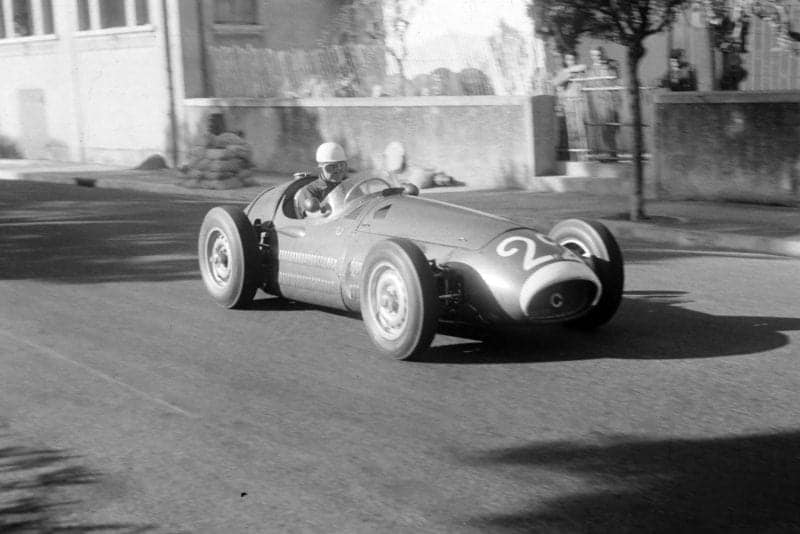
Lance Macklin failed to qualify his Maserati
Motorsport Image
Originally the three practice periods were planned for the earlier hours of the morning on the Thursday, Friday and Saturday before the race, but certain teams pointed out the impossibility of trying to carburate at 6 am for a race to be held at 3 pm, so Thursday saw the practice changed to the afternoon. Another dubious rule had been inserted in the regulations, which said that only those times recorded on Thursday would count for the front row of the starting grid, the rest of the rows being decided in the early morning practices.
This was to encourage drivers to try hard on the opening practice and thus induce the public to pay to come and watch that practice, and needless to say the idea was not at all popular with the drivers, many of whom had not driven before on this difficult winding 3.145 kilometre circuit.
The only drivers not out for the first practice were Hawthorn, whose Vanwall was delayed by the Channel crossing, Wharton, who was going to be a non-starter after his Silverstone accident, Macklin as the Moss Maserati was still being rebuilt, and the complete Gordini team who just were not ready.
Fangio and Moss were soon in their stride and Ascari, using Castellotti’s car, was not far behind, while a fourth Mercédès-Benz, another long-chassis car, was being driven by engineer Uhlenhaut, so that he could find out what the circuit was all about and know what the drivers meant if they complained about the cars.
Guiseppe Farina rounds the hairpin
Farina was trying both a Ferrari 555 and a 625, the latter fitted with new brakes that were bigger and better than before. It was not long before the usual practice split-second battle began between Fangio, Moss and Ascari, the Italian now on his own Lancia and also at time on the Turin team’s spare car. They had five cars present, all fitted with yet another type of oil cooler, this time having a normal oil radiator mounted on each side of the cockpit, between the body and the pannier fuel tank.
As would be expected, Behra was the fastest Maserati driver and though he joined in the dice for the front row he could not approach the two short chassis Mercédès-Benz cars. During this practice period Herrmann had a bad slide at the top of the hill before the Casino and went through a stone palisade, wrecking the car and damaging his leg and his lungs, while Schell broke one of the 555 Ferraris so that the end of practice saw only the Lancia learn feeling happy and confident. The result of the battle for the front line was in the order Fangio, Ascari, Moss, Castellotti, Mehra, Trintignant, Villoresi and Musso, the rest being some way behind, so the first three could rest content.
Next morning saw practice start just before 6am and this time Gordini had his three cars out, the lone Vanwall appeared, driven by Hawthorn, and Macklin was circulating. Ferrari were undecided about their race order, but Farina wanted to drive the 625 with the new brakes, still refusing to get used to the handling of the “Super Squalo”, Trintignant was given the second 625 and Schell one of the new ones. For the second new car they brought in Taruffi and Frere and they both practiced, to see who would start in the race.
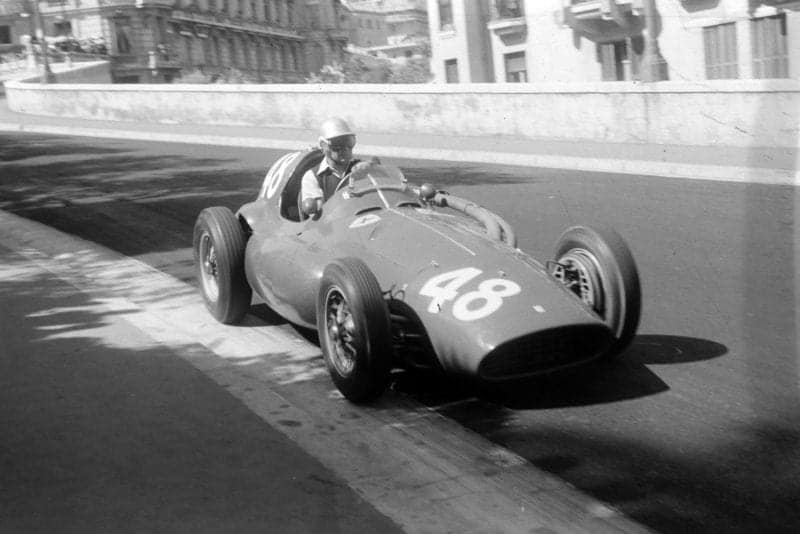
Piero Taruff lined up 15th in his Ferrari
Motorsport Images
Towards the end of practice Moss tried the short Mercédès-Benz to be used by Fangio and got within one-tenth of a second of the Argentinian’s time, whereas on his own car he was more than two seconds slower. Although Moss was not very happy about this the engineers were content, for they had learnt a great deal more about weight-distribution. With Herrmann out of the race, Simon was co-opted into the Mercédès-Benz team, with Le Mans as the long term view, and he was given the spare long-chassis car and began the difficult task of learning how to control the really fast Grand Prix car.
Another driver who was trying to convince himself he could cope with a 1955 Grand Prix machine was Chiron and he was making steady progress, but not lapping terribly fast. The Vanwall, with its fuel-injection and Amal GP carburetter bodies, used as air intakes and to provide the throttles, was sounding its usual crisp self and going quite well. Behra was now getting into his stride and Castellotti was still showing great form.
“Macklin poured oil all over the track from the green Maserati and there was a 40 minute delay while the mess was cleared up and some rude words exchanged”
On the third day things were due to start at 6:15am, but Macklin poured oil all over the track from the green Maserati and there was a 40 minute delay while the mess was cleared up and some rude words exchanged. All the time the weather was proving perfect, and the last practice period saw the top boys trying all they knew, though quite why was difficult to understand, for the front row was already decided.
In spite of this Ascari turned 1min 41.1sec equalling Fangio’s best for Thursday, just to show the Germans that the Lancia was going well, and Fangio replied with a lap one-tenth of a second slower and then Castelloti did 1min 42sec, which surprised everyone and probably himself as well, and practice finished with everything at fever pitch and excitement high for the race. As an interlude Uhlenhaut drove Moss’s Maserati.
Race
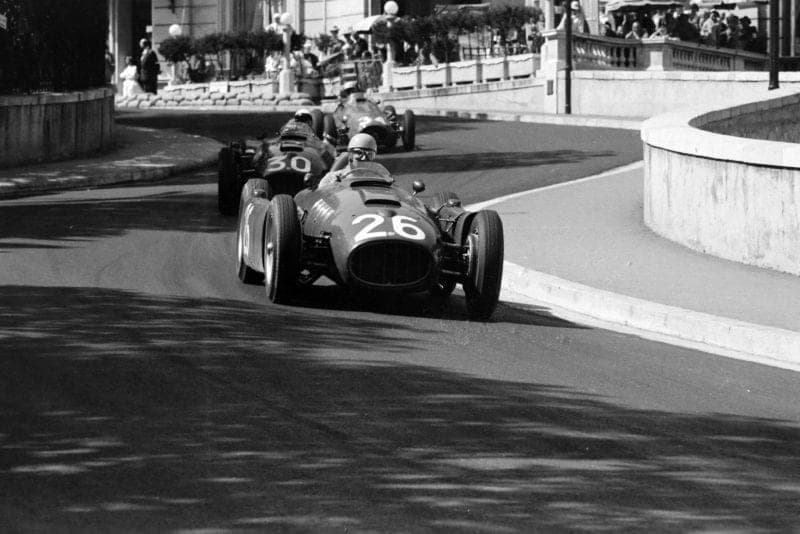
Alberto Ascari led before his plunge into the harbour
Motorsport Images
Starting at 2:45pm on Sunday, May 22nd, the Grand Prix was to run over 100 laps of the tiny circuit and everyone was anticipating a great deal of bumping and boring to be indulged in with so many top Grand Prix cars and drivers on the grid. Of the total entry that practised Macklin and Whiteaway did not qualify and 20 cars lined up on the quayside facing towards the gasworks hairpin, with Fangio, Ascari and Moss on the front row, last year’s World Champion being on the inside; behind were Castellotti and Behra, followed by Mieres, Villoresi and Musso, Trintignant in the best Ferrari, with Simon alongside and the others in threes and twos behind.
At flag-fall there was nothing to choose between the leaders and out of the hairpin Mercédès-Benz led Lancia with a thundering horde right behind them. Fangio appeared out of the tunnel on this far side of the quay, well ahead of Castellotti, Moss, Ascari, Behra and the rest and away went the Argentinian to build up a lead. After five laps Moss scrabbled past Castelloti but by now Fangio was some 7sec ahead and so when the turmoil began to settle a bit and things took some semblance of order Fangio still led.
At lap 10, he was 9sec in front of Moss, who was the same distance ahead of a close trio comprised of Castellotti, Ascari and Behra, the first two passing and repassing, then came Mieres running alone, to be followed by another dicing trio, Villoresi, Perdisa and Trintignant. Schell and Hawthorn were in close company, and the rest were beginning to straggle, with Farina right at the back having dented his car’s nose on someone’s tail on the starting melee and been pushed to the back.
So close were the cars in the opening laps that nearly everyone had dents at front or back, and Rosier had spun completely and wiped off the tail of his car, the oil tank later coming adrift. Fangio and Moss were well out on their own, while Ascari was being harassed by Castelloti and then Behra passed both Lancias and took third place. At 20 laps the gap between the two short-chassis Mercédès-Benz cars was still around 9sec, but they were more than that much in front of Behra’s Maserati and the two Lancias.
“Musso had broken his Maserati and Manzon and Taruffi had been at the pits, the furious pace beginning to tell”
Trintignant got past his two adversaries and began to close on Mieres who was in sixth place, and on lap 23 Hawthorn was overdue, arriving later with a broken throttle linkage on the Vanwall and having to retire. Simon burst the engine on his Mercédès-Benz, Musso had broken his Maserati and Manzon and Taruffi had been at the pits, the furious pace beginning to tell. The leaders were lapping, at 1min 46sec and soon Moss closed up on his team-mate and the two cars circulated a few feet apart, in complete command of the race and seemingly all set to give a Mercédès-Benz demonstration.
On lap 35 Castellotti hit a kerb and the next lap a rear tyre went down and he stopped to change it, taking on fuel at the same time, and then Behra called into his pit with trouble, all of which left Ascari securely in third place, but more than 40sec behind Fangio. Trintignant had caught and passed Mieres, but now the Maserati driver was beginning to retaliate and they were having at private race together, while Castelloti was working his way up from ninth place, to which he had dropped.
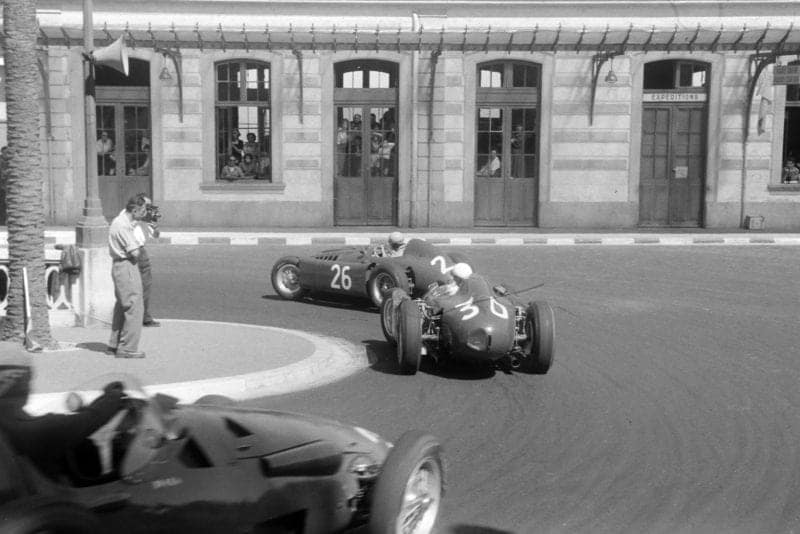
Castellotti chases Ascari
Motorsport Images
Perdisa had been going consistently, shaking off Villoresi, but when Moss lapped him he tended to get in the way, and the Mercédès-Benz driver gave him a severe “talking-to” as he eventually got past. On lap 50, just halfway through the race, Fangio come to a sudden halt on the far side of the circuit, by the railway station, when his transmission broke and Moss appeared past the pits on his own; then Behra and Perdisa were flagged into the pits together and they changed cars and went off again, the Frenchman now being seventh and having regained the lap he lost due to his pit stop.
With only Moss and Ascari on the same lap the race began to settle down, there being 84sec between the two cars on lap 60, and when on lap 65 Mieres had the transmission of his Maserati break, just after he had repassed Trintignant, the result seemed settled. Moss was circulating steadily and smoothly and though Ascari was resigned to second place he was now being harassed by Perdisa, for the young Maserati driver, having been lapped by Ascari, suddenly began to drive at a furious pace and sat right behind the Lancia. For lap after lap this went on and Ascari just could not get rid of the Maserati on his tail, while Moss was beginning to make up a full lap on the Italians, and everyone waited to see when he would lap the Italian champion.
As has happened so often to Moss, what was going to be a certain victory was snatched from his grasp, but this time with unexpected additional drama. As he completed lap 81 a cloud of smoke poured from under the bonnet as the engine burst and spewed oil onto the exhaust pipes and he drew into his pit.
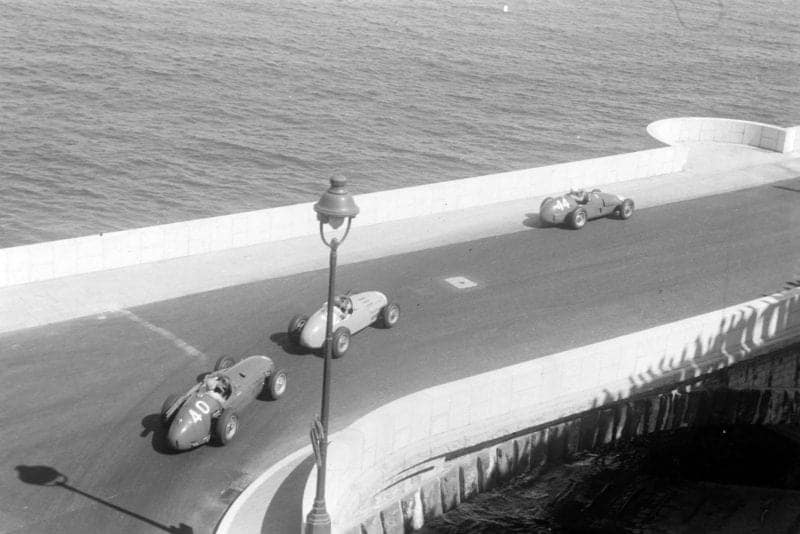
Maurice Trintignant leads the chasing pack
Motorsport Images
While most people were watching to see if anything could be done to the Mercédès-Benz Ascari was coming down the hill approaching the chicane leading onto the promenade, still with Perdisa just behind him, and then without warning the Lancia slid straight across the road, crashed through the straw hales and sand-bags and went over the edge to plunge down into some 15 feet of water, the hot engine sending up an enormous cloud of steam. For some moments there was chaos, and while men in “Frogmen” suits swam to where the Lancia had disappeared and boats sped across the harbour, Ascari surfaced and was retrieved suffering only front a slight cut on the nose, but very lucky to have escaped drowning.
“In a few seconds the whole race had changed completely”
In a few seconds the whole race had changed completely, Trintignant was now left in the lead, followed by Castellotti and Behra, but the Maserati spun almost immediately and stalled and now Perdisa moved up into third place. At last the excitement died down and the last 10 laps closed quietly, with a very surprised Trintignant the winner, the Ferrari team finding it hard to believe, and Castellotti in second place. Farina kept profiting by retirements and climbed to fourth place, followed by Villoresi, Chiron who had kept his Lancia going steadily, Pollet with a lone Gordini, with the second 555 Ferrari, having been shared by Taruffi and Frere, in eighth place. The other car of this type driven by Schell had disappeared in a cloud of smoke that was classic. As in complete anticlimax Moss pushed his broken Mercédès-Benz to the line to be classified ninth and last.
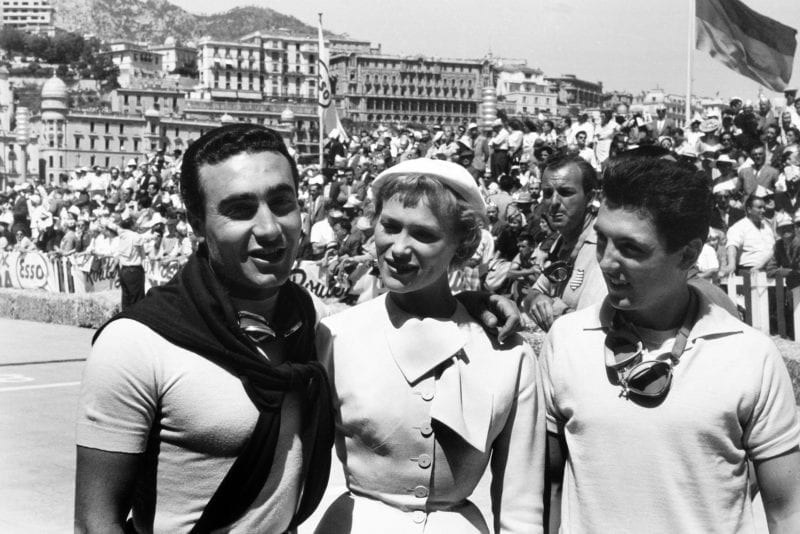
Eugenio Castellotti and Cesare Perdisa are congratulated after the race
Motorsport Images
